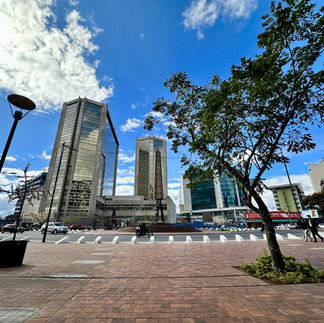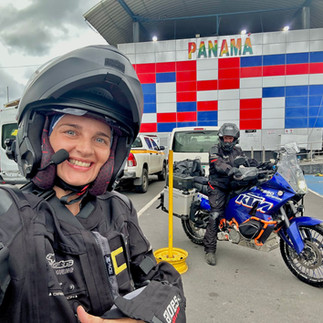A good second take!
- ggiannoccaro
- 24 dic 2023
- Tempo di lettura: 6 min
We are on the Bridge of the Americas, below us we see the last lock of the Panama Canal, the one that opens the doors of the Pacific to sailors.
9 years ago we were there, waiting to start our cruise around South America which would take us to Antarctica, the Cruise to the End of the World.
Although the feelings of those moments are still firmly imprinted in my memory, it seems like a lot of time has passed; a lifetime.
Here we are, again in Panama, ready for another tour of South America but this time on a motorbike.
We left Belize City on November 2nd heading to Panama, where the a flight to Bogota was waiting for us to fly over the Darien Gap, 106 km of forest which interrupts the Pan-American Highway and which makes impossible the land connection between Panama and Colombia.
Unfortunately, a couple of days after our departure, probably also due to the torrential rains we encountered, the dashboard of our motorbike flooded, shutting down completely and also causing difficulties in starting the motorbike.
With a cold engine the bike would start normally, but one turning off the engine, you had to wait about twenty minutes to turn it back on again.
So we decided to return to Belize, to order a new dashboard and then get back on the road.
Once home I ordered the dashboard from the US Dealer from which I normally get supplies.
The dashboard was delivered within 5 days to my freight forwarder in Miami who forwarded it to Belize by air.
In all, including weekends, the replacement arrived in Belize in 11 days.
However, once the Dashboard was installed, the ignition problems remained.
Once I connected TUNECU (a diagnostic software) to the control unit of my 990, I found two errors: an immobiliser problem and a CAN BUS communication problem.
The immobiliser is a kind of native KTM alarm that blocks all electronics if the system does not recognise the ignition key.
The CAN Bus is a communication protocol which has the function of allowing the various components of the vehicle to communicate with the control unit (ECU, Electronic Control Unit).
Electronics have certainly made our vehicles safer, better performing and less polluting.
However, when an electronics problem arises, my anxiety grows because my skills on the subject are almost nil.
So I contacted my two guardian angels for advice: Ciro Ciruzzo aka Gunter Mayer in Miilano and Tony Pappa of Motopsyco in Guatemala City.
Both suggested me to check all the electrical connections of the immobiliser, to try changing the ignition relay and, if these attempts did not produce results, to replace the immobiliser.
In the end I had to order the Immobiliser which is actually made up of an entire system: the ignition lock, a control unit, 3 keys (one of which has the function of programming new keys if the ones supplied are taken), two caps tank and the saddle opening system, also equipped with a lock.
In fact, by replacing the ignition key, you are also forced to replace the two fuel caps and the saddle lock if you don't want to go around with a bunch of keys.
So new order to KTM World in the USA and in a further 2 weeks the spare part arrived in Belize.
Unfortunately, the coupling of the keys to the control unit, or their programming, can only be done by a KTM Dealer.
The closest dealer and in any case somehow in the same direction as our journey to Panama was the one in Guatemala City.
So the decision was to rely on the Guatemala City Dealer.
To speed up the intervention we agreed with Tony Pappa to take the motorbike to his workshop, assemble the entire system there and then take the motorbike to the Official KTM Dealer for programming.
The long stop at home waiting for spare parts allowed us to reflect on the luggage we had decided to bring with us.
Thanks to the test of almost 2000 kilometres done in the first attempt to reach Panama we understood that we were overloaded and that all that weight would prove to be a big problem on the dirt, sand and mud roads that we would encounter in South America.
We therefore decided to subject our luggage to a serious slimming treatment.
The first bag we decided to leave at home was the one intended for camping equipment.
Tent, sleeping bags, mattresses, pillows and various accessories remained at home.
We will plan the stages always making sure we have a place to crush in the evening.
We have also significantly reduced the volume of our personal bags, I would say by almost half.
We will do laundry more often and if we need something we will buy it along the way.
So on December 12th we left to Panama, once again under pouring rain that accompanied us till Rio Dulce, in Guatemala where we spent the first night.
On the second day, having reached Guatemala City, greeted by the usual terrible traffic, we handed the motorbike over to Tony and took refuge in a B&B.
The next day the KTM dealer organised the transport of the motorbike to their workshop and programmed the immobiliser so that by 4pm on Thursday 14th December we were once again ready to resume our journey to Panama.
There are only two weekly cargo flights from Panama to Bogota, on Wednesdays and Saturdays.
If sent with the Wednesday flight, the motorbike is returned to Bogota on Thursday; if sent with the Saturday flight on Monday.
Our goal was to take the flight on Wednesday, otherwise if we had taken the flight on Saturday 24 December, the motorbike would have been returned to us only on Tuesday 27 December, due to the Christmas holidays.
To be on the Wednesday cargo flight we had to reach Panama by Monday the 18th at the latest.
In fact, the airline requires you to carry out all the formalities the day before boarding, in our case on Tuesday.
In short, we only had 4 days to cover the almost 2000 kilometres that separated us from Panama.
You will say, about 500 kilometres a day: what do you want it to be!
Unfortunately, Central America is not Europe and this is why we love it.
There are no highways.
The roads are all one lane, full of holes and bumps to reduce speed, with all sorts of animals free to "graze", with heavy vehicles carrying goods in all directions and not particularly suitable for traveling at night.
Not to mention the fact that 10 customs offices and 10 borders awaited us to cross:
Exit from Guatemala - Entry into San Salvador. Exit San Salvador - Enter Honduras. Exit Honduras - Entry Nicaragua. Exit Nicaragua - Entry Costa Rica. Exit Costa Rica - Entry Panama.
At each border, in addition to the paperwork relating to Immigationl, you have to deal with customs.
Upon entry into each country, a temporary import permit must be issued for the vehicle and, in many cases, an insurance policy is also required.
Upon leaving the country this permit must be closed and you must make sure that the authorities have really closed it, otherwise, as has already happened to me, you will have serious problems the next time you enter that country.
Your passport will show that you have a vehicle still circulating in that country, with the temporary permit expired and there will be very heavy fines.
We in Europe have forgotten what it means to move between borders and customs.
We spent approximately:
2 hours between the borders of Guatemala and Salvador.
4 hours between the borders of Salvador and Honduras
5 hours between the borders of Honduras and Nicaragua
3 hours between the borders of Nicaragua and Costa Rica
2 hours between the borders of Costa Rica and Panama.
On the afternoon of Monday 18 December we reached Panama.
The next day we went to the offices of Overland Embassy, a well-known agency among Overlanders, specialised in assistance with vehicle transport to and from Colombia.
Once we had filled out some documents, one of their representatives accompanied us to the airport where he carried out all the customs procedures for us.
Around 12pm we handed over our motorbike to the airline.
Wednesday 20 December, both we and our 990 were on a flight to Bogota'
Once we reached our destination we met another Overland Embassy representative who accompanied us to the hotel.
Tomorrow he will come to pick us up to take us to the airport and assist us with the motorcycle collection formalities.
This new tour of South America seems to have really begun
































Commenti